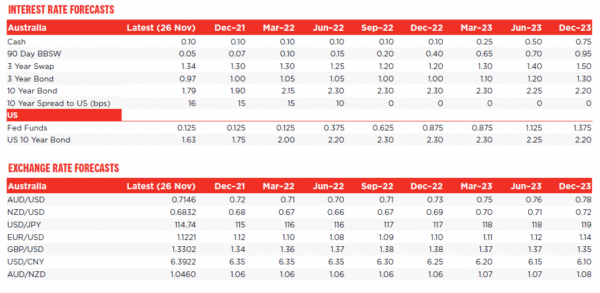The US economy has experienced two significant shifts in the past two months: the momentum lost in the September quarter because of delta has been regained; and the scale, breadth and expectations of inflation have risen to multi-decade highs. Based on this progress and FOMC member commentary over the past fortnight, the December 14–15 meeting is expected to see significant change in the Committee’s approach to policy.
At that meeting, we now expect the taper to be accelerated to conclude in March 2022, making room for three 25bp rate hikes at the June, September and December 2022 meetings.
This compares with our previous view that the taper would extend to June prior to the first rate hike in December.
This policy approach will be the result of a careful assessment of the spectrum of risks that the US economy faces.
With respect to activity, the threat from delta looks to be subsiding, with rebounding consumption and robust investment pointing to growth at a multiple of potential in Q4 2022 as well as the first half of next year. Further, the run of weak readings for employment through mid-year have largely been revised away, and current momentum in labour demand is more than enough to see the economy reach full employment by the end of 2022.
The risk for activity is now actually that labour demand runs too far ahead of labour supply in coming months as participation remains impaired, leading to unsustainable gains in wages and additional support for already-elevated inflation expectations. These are circumstances which risk turning a transitory period of high inflation into a persistent force which will be difficult to control without inflicting a material cost on the economy. It increasingly looks likely, that price pressures related to supply and re-opening which drove annual inflation to 6.2%yr at October will take time to dissipate.
With this potential prospect of inflationary forces proving to be more persistent than anticipated and further boosting wages growth and inflationary expectations, the FOMC will not want to be seen to be persisting with a policy stance that is unnecessarily fuelling inflation pressures. With the growth prospects pointing to eventual maximum employment, the better policy approach is to begin the wind down of emergency stimulus sooner rather than later.
These issues may preclude the FOMC the luxury of delaying the first rate hike until the goal of maximum employment can be absolutely declared.
Albeit just a month on from the taper commencing, a doubling of the monthly reduction in purchases to $20bn for Treasuries and $10bn of mortgage-back securities, to complete the program in March instead of by June, now seems likely.
Although the market has moved to price in a first hike just a month after the current end of the taper in June 2022, we do not believe such a quick turn is likely given tapering is not tightening and the economic threshold for tightening (i.e. raising rates) has always been much higher.
A three month pause in policy normalisation to June 2022 is most likely, to be followed by two further 25bp increases in September and December as the US economy continues to grow above trend and maximum employment converges with full employment – as individuals currently sitting outside the labour market are attracted back in and find work.
From end-2022 to June 2024, we then see a further three rate hikes (one every six months) to a federal funds rate of 1.625%, unchanged from our prior call. This end point highlights our belief that, while inflation risks are currently rife, prudent policy and the passage of time will see them abate, allowing the FOMC to remain accommodative and the economy to grow at trend in 2023–25.
Moving rates earlier will increase the chances of being able to avoid the overtightening / policy mistake scenario we have seen in previous cycles.
Our expectation that the economy can settle at trend growth with full employment is also behind our view that the US 10-year yield will hold above the federal funds rate over the entire forecast period, only retreating from a peak of 2.30% at September 2022 to 2.20% end-2023 and 2.00% end-2024 as inflation risks abate.
This dynamic, risk-aware policy making by the FOMC is also expected to keep the US dollar in a tight range on a DXY basis over the forecast period. While divergent rate expectations and risks related to delta are set to weaken the Euro to June 2022, once the first hike is delivered by the FOMC and prospects for Europe and the global economy, and Asia in particular, strengthen, the DXY index is forecast to fall back from 98.6 to 97.4 end-2022, and 95.9 end-2023.
Underlying this result is not only the market’s confidence in the FOMC’s ability to deliver growth sustainably at trend without persistent inflation risks, but also a view that the global recovery will continue to strengthen over the period, reducing the US dollar’s attraction as a safe haven. Asia is expected to lead, both in terms of actual outcomes and sentiment.
The Australian Dollar to Reach a Low of USD0.70 by June 2022
This revised profile for FOMC policy has important implications for our views on the AUD.
Readers will have noted that we expect to see the USD peaking around the time of the first rate increase from the FOMC.
That timing will broadly coincide with the likely low point in the AUD/USD.
Our changed view for the FOMC has major implications for the outlook for the AUD.
Market pricing is also bringing forward the timing of the FOMC hikes and that has already taken some toll on the AUD, which has tumbled from USD0.75 to USD 0.715 over the last month.
That 4.5% fall is partly due to USD strength (up 3.2% against EURO and in DXY terms) and particular market negativity around AUD, specifically in the wake of the ultra dovish stance being signalled by the RBA Governor in recent speeches.
We have also seen a 20% fall in the monthly average iron ore price between October and November, although today’s spot is 5% above the November average.
Market pricing continues to anticipate 3-4 rate hikes by the RBA in 2022 – well ahead of the forecast we released in June that the tightening cycle will not begin until February 2023.
Through the first half of 2022 we expect markets to adjust to a much later beginning to the RBA’s tightening cycle triggering some further downward pressure on the AUD.
However, readers will note our view that the USD is likely to reach its high point by June 2022 as Europe and Asia ‘s growth prospects improve relative to the US and a strengthening global recovery weighs against “safe haven” currencies like the USD.
In turn, that modest expected deterioration in the USD will boost the AUD.
Other factors that will provide some support for the AUD will be Australia’s outperformance in terms of vaccination rates; strong growth in Australia in 2022; and stimulatory policy in China.
However, none of those factors will be sufficient to see the RBA lifting the cash rate earlier than our February 2023 target
We now see the low point in the AUD at USD0.70 by June lifting to USD 0.73 by end 2022 and sustaining that upswing in 2023 to USD0.7
In these uncertain times there are multiple risks to this outlook in particular the risk posed by interest rates.
The bottom of the AUD cycle may be even lower than USD0.70. We suspect that some of the multiple rate increases priced in for the RBA reflect distortions, including liquidity, in the Australian interest rate market while currency markets may be more wary of that profile.
Certainly, the jolt to AUD in the wake of the Governor’s recent speeches has not been reflected in interest rate markets.
The disappointment in markets with the RBA’s inertia may be exacerbated when it does not closely follow the FOMC even though it is quite clear that Australia is facing different challenges on the inflation and wages front.












